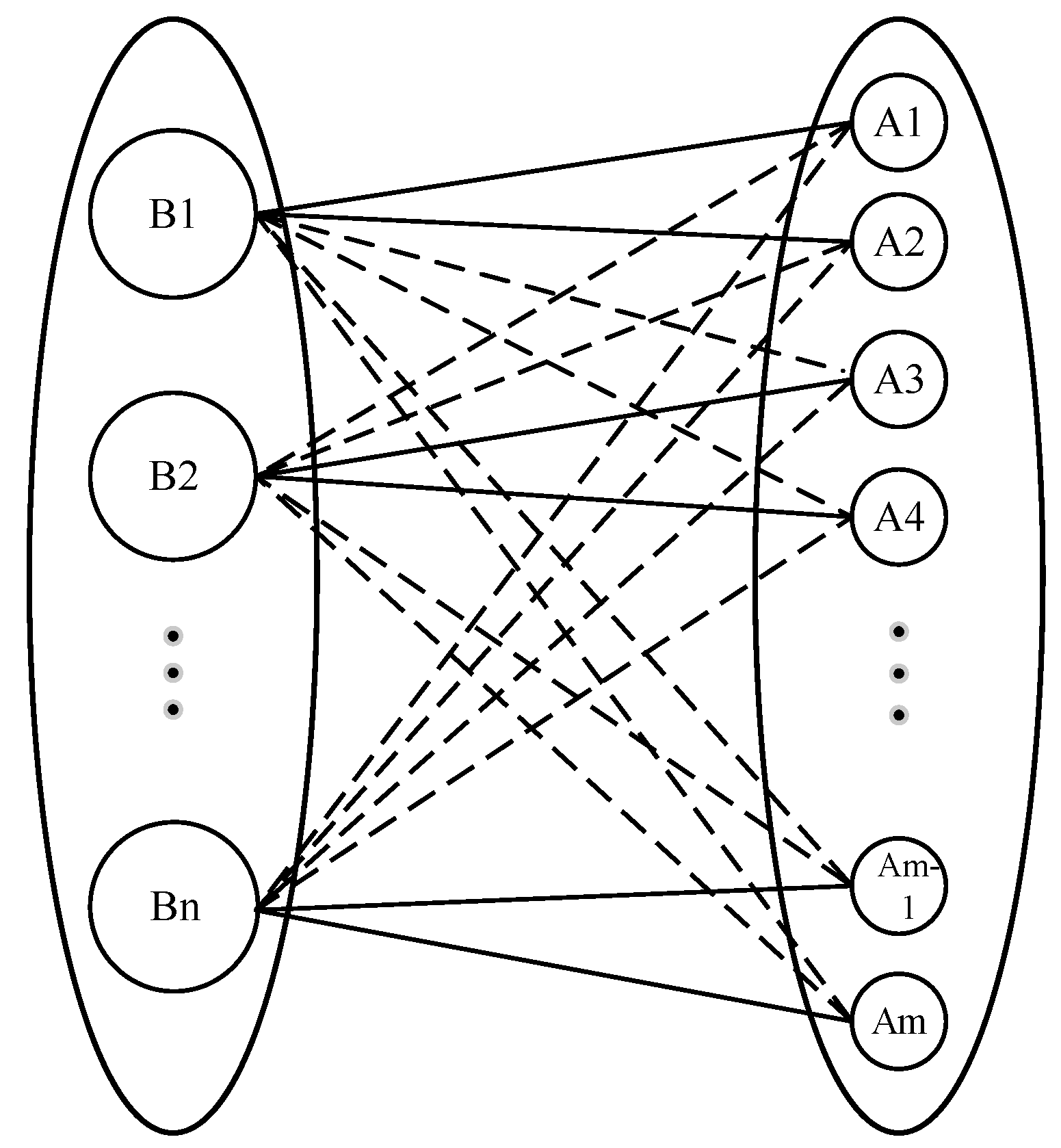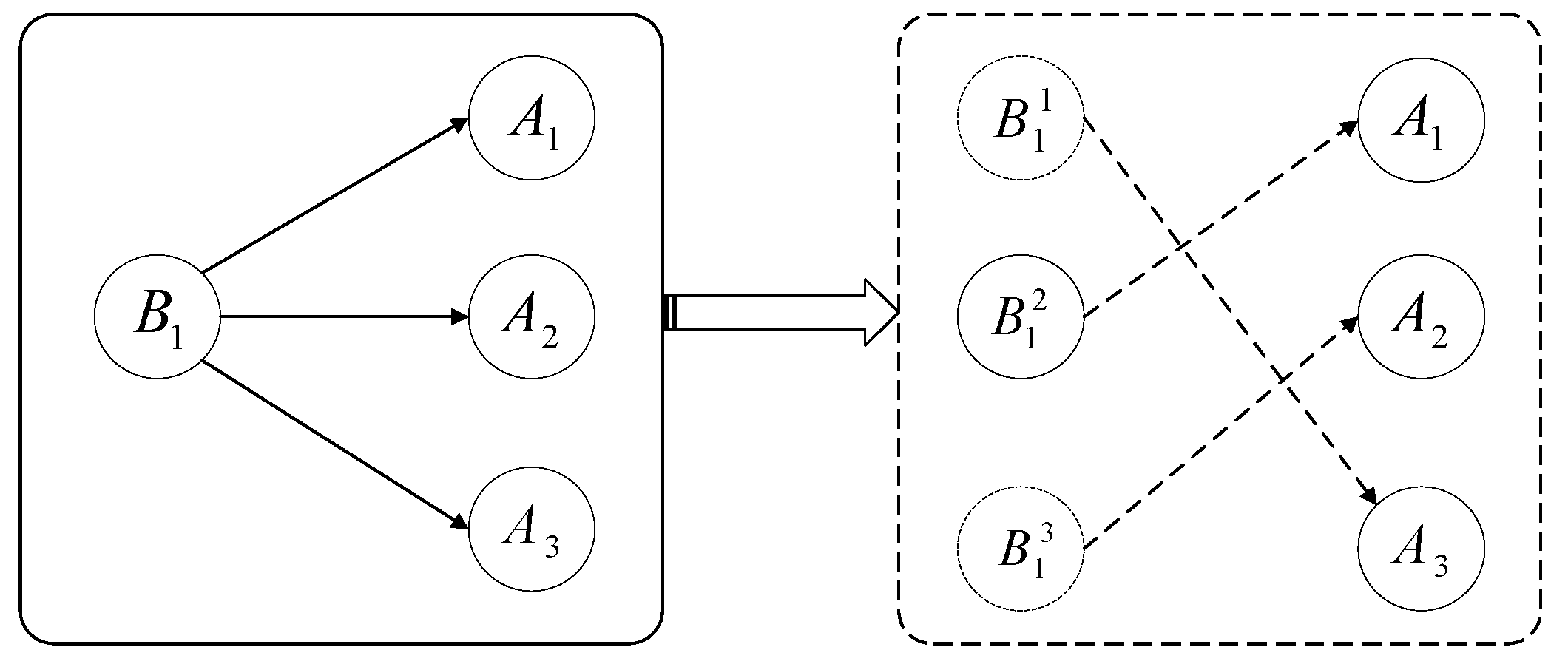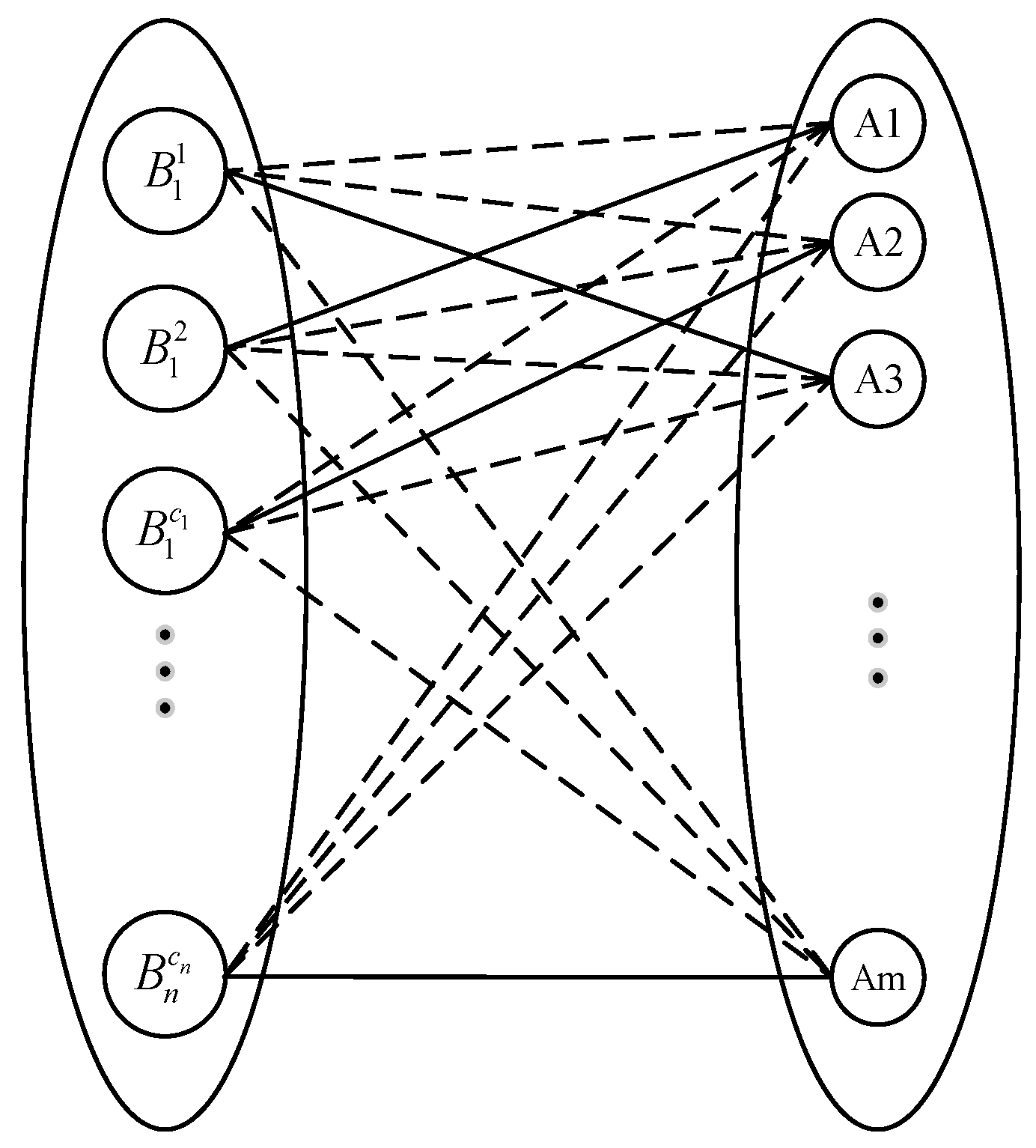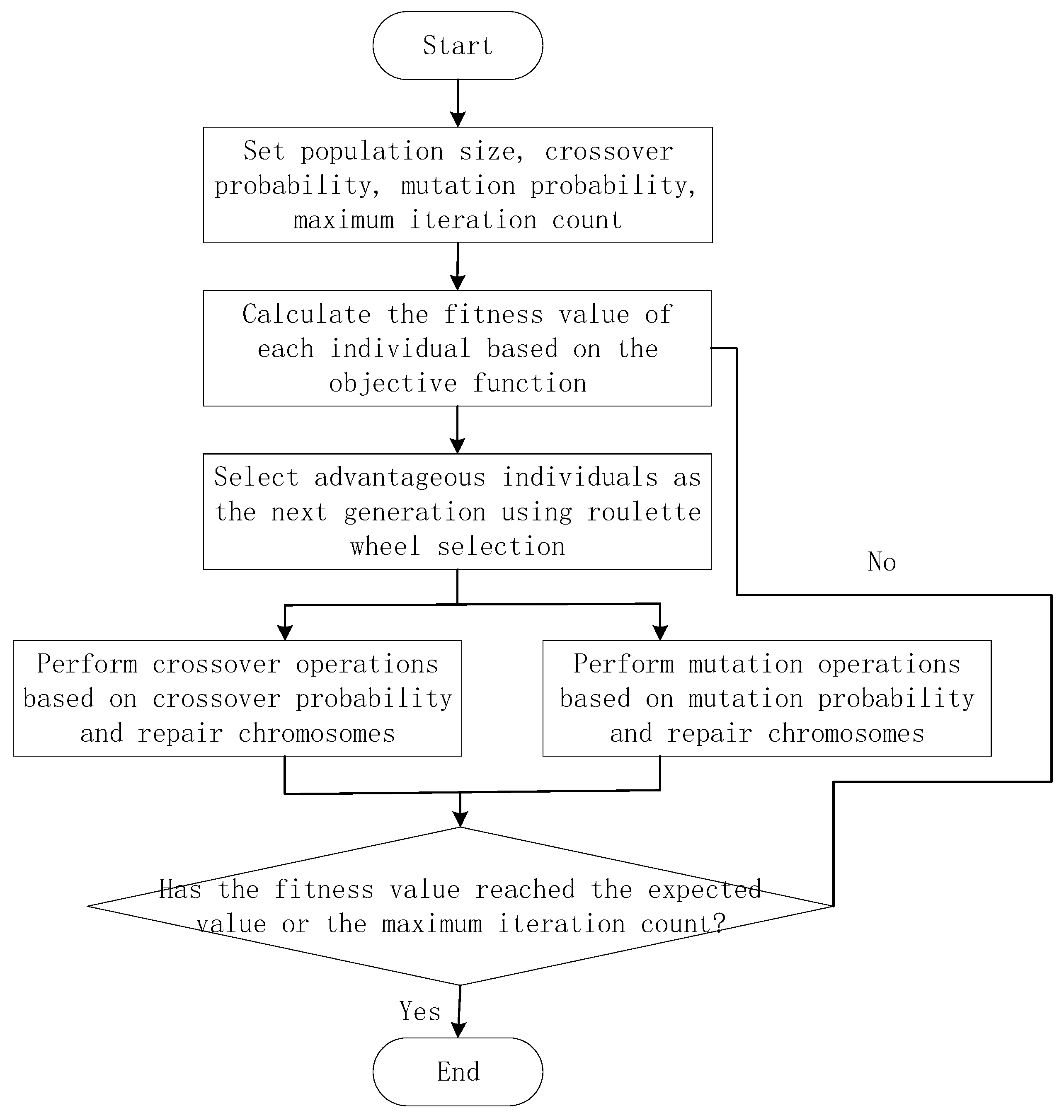1. Introduction
The research field of high-speed railway crew planning has consistently been a prominent focus within high-speed railway management optimization. Current studies have yielded substantial findings primarily concentrated on optimizing crew routing and formulating crew schedules. Tian Zhiqiang [
1] modeled the problem as a set-covering model with minimum cost as the optimization objective, utilizing an improved ant colony algorithm for computation. Zhang Zheming [
2] developed a space–time state network integrated with crew regulations, formulated an integer programming model for the network, and designed a Lagrangian algorithm for solving the problem. Hoffmann [
3] proposed an arc-flow model aimed at minimizing crew costs, employing column generation techniques to enhance solution efficiency. Fuentes [
4] introduced a crew scheduling model based on network flow to reduce labor costs, further implementing a time-based personnel clustering decomposition approach to solve the problem. Hanczar [
5] designed a two-stage model and devised separate solution algorithms for large-scale instances, validating the model’s and algorithm’s effectiveness through simulation studies. A review of prior research reveals that the majority of these studies have focused predominantly on reducing labor costs or minimizing working hours, with limited consideration for crew perspectives in the formulation of crew schedules.
In the research of similar topics in aviation systems, several studies based on the perspective of crew members have emerged. Felici [
6] established a preference-based integer programming model and designed a heuristic algorithm to solve this problem. Maenhout [
7] integrated crew preferences into the objective function of the model, designing a decentralized search algorithm and comparing it with a branch-and-price algorithm based on the constructed integer programming model. Quesnel [
8] incorporated crew preferences into this problem, establishing a preference-based mathematical model and employing a column generation algorithm to solve it. Bahareh [
9] developed a scheduling model based on crew preferences and qualifications, and used a genetic algorithm to solve this problem, aiming to achieve an optimized crew scheduling scheme.
In recent years, the efficiency of team collaboration in high-speed railway crew operations has been declining, coupled with increasing personnel turnover. Thus, exploring crew scheduling methods from the perspective of crew members has become particularly important. In practice, the preparation of high-speed railway crew plans typically involves three main steps: first, the matching of crew members; second, the generation of crew routes; and finally, the matching of crew members to the generated crew routes. Steward matching forms the foundation of crew plan preparation. If crew members with high satisfaction can be identified during the matching process, it can significantly enhance their job satisfaction and team collaboration efficiency, while also improving personnel stability. However, current research in this area remains relatively limited. Against this backdrop, the theory of bilateral matching decisions offers a novel research approach.
Bilateral matching theory addresses the problem of matching discrete resources between two disjoint sets and has become a research hotspot in recent years. It is widely applied in various fields, including male–female marriage matching, person–position matching, and matching between students and mentors. Numerous scholars have conducted in-depth studies on this problem, focusing on aspects such as stability and satisfaction. GALE et al. [
10] established the definitions of stable and optimal matchings through the study of student admissions and marriage issues, confirming the existence of stable matchings using the Gale–Shapley algorithm. Yu D [
11] designed a bilateral matching model based on intuitionistic fuzzy functions for person–job matching, obtaining optimal results through multi-objective decision-making models. Li Mingyang [
12] converted matching preference order information into satisfaction levels to construct an optimization model for the maximum weight matching problem, achieving optimal bilateral matching results. Kong Dezai [
13] introduced a preference list simplification rule to reduce the scale of bilateral matching problems and demonstrated that stability constraints within the optimization model can yield one-to-many stable matching solutions. Jia Fuqiang [
14] created a bipartite graph focused on travelers and routes, proving from a graph theory perspective that the stable matching of this bipartite graph determines the final path selection, and established two types of multi-objective optimization models considering and disregarding the effects of traffic flow and capacity. Kong Dezai [
15] targeted bilateral matching issues with individual and reciprocal preferences, built a stable matching optimization model to maximize overall subject satisfaction, and transformed the multi-objective optimization model into a single-objective model using a weighted sum method based on membership functions to find the optimal stable matching schemes for bilateral subjects. Yang Qin [
16] converted the one-to-many bilateral matching issue between rescuers and rescue tasks into a one-to-one perfect matching problem, establishing a bilateral matching decision model that maximizes perceptual congruence and acceptance. Liu Jie [
17] transformed the one-to-many bilateral matching problem between instructors and graduate students into a one-to-one issue, developing a preference-based perceived satisfaction function for both teachers and students using prospect theory, and solved it using a genetic algorithm. Xiao Hanqiang [
18] under the conditions of bilateral subject satisfaction and intermediary benefits, calculated the prospective values between parties using prospect theory and constructed a dual-objective optimization model aiming to maximize the aggregate prospective values. Yuan Duoning [
19] addressed the one-to-many bilateral matching issue between elective surgery patients and surgeons, creating a multi-objective optimization model to achieve a stable matching scheme that meets expectation levels, using a non-dominated sorting genetic algorithm with an elite strategy. Kong Dezai [
20] focused on bilateral matching problems where one party provides preference order information and the other has reciprocal preferences, devising a stable matching optimization model that maximizes satisfaction for both sides and determined that the optimal solution corresponds to Pareto efficient matches. Le Qi [
21] investigated the bilateral matching problem using triangular intuitionistic fuzzy number information to achieve the highest triangular intuitionistic fuzzy satisfaction for venture capitalists and enterprises, building a multi-objective bilateral matching model and converting it into a single-objective model using linear weighting and centroid methods to obtain the “best” bilateral matching scheme. Li Woyuan [
22] transformed interval intuitionistic fuzzy set matrices into score function matrices to build a bilateral matching model based on score functions and matching matrices. Zhang Lili [
23] constructed an advantageous attribute scale based on objective evaluations of subjects, introduced a formula for individual comprehensive situations, converted multi-objective optimization into single-objective optimization using a subordination-weighting method, and used the Hungarian method to secure the matching scheme with the highest satisfaction and stability. For the one-to-many two-sided matching problem based on ordinal preference information, Li Mingyang [
24] constructs a multi-objective optimization model with the goal of minimizing the sum of ordinal values for each party under stable matching conditions. The multi-objective optimization model is then transformed into a single-objective optimization model to obtain the optimal matching result.
From an application perspective, the aforementioned studies extend the bilateral matching theory to various domains, including marriage, doctor–patient, admissions, and rescue scenarios, encompassing matching subjects such as individual-to-individual, individual-to-job, and individual-to-resource. Theoretically, these studies address the conversion of one-to-many bilateral matching issues into one-to-one scenarios by defining virtual subjects, thereby constructing multi-objective optimization models using linear programming techniques. These models are further simplified into single-objective formulations, or solved using intelligent multi-objective optimization algorithms, effectively resolving bilateral matching problems.
The problem of crew matching in the field of high-speed railway crew planning research involves matching between individuals, where the process can be viewed as a decision-making process with the chief steward and stewards as the primary entities in bilateral matching. By introducing bilateral matching decision theory, theoretical support can be provided for efficient and stable crew matching. Accordingly, this paper applies bilateral matching decision theory to the problem of crew matching in high-speed railway trains. Based on the preference order theory, a one-to-many bilateral matching multi-objective optimization model is developed, considering the satisfaction of both matching entities. Optimization solvers and intelligent optimization algorithms are employed to conduct simulations and calculations for various problem scales under different scenarios. This not only enhances the field of high-speed railway crew planning research with significant application value but also expands the application scope of bilateral matching theory.
3. Algorithm Design
The genetic algorithm is a population-based intelligence algorithm founded on random, this paper designs a genetic algorithm to solve the bilateral matching model for crew members. By using real-number encoding, the matching scheme of chief stewards and stewards is represented as chromosomes. Subsequently, a fitness function is constructed, and crossover and mutation operations are applied to alter the matching relationships between the bilateral subjects. The core idea is to find the optimal crew shift matching scheme that satisfies the bilateral subjects’ preferences through iterative processes, while ensuring one-to-one matching between the bilateral subjects.
3.1. Coding
For the characteristics of the problem, this paper adopts a real number coding scheme. The coding method represents the steward
by number
, which is expressed as a gene position on the chromosome, arranged in increasing order of natural numbers. The virtual chief steward
is expressed as a gene value on the chromosome. The chromosome can be represented as
, where
. Here,
denotes an individual
, and
represents a population with a size of
. The coding scheme is shown in
Figure 4.
3.2. Initial Population Generation
In generating the initial population, a virtual chief steward number is first generated in the first locus according to the principle of the smallest preference order. Then, the virtual chief steward number with the smallest preference order among the remaining virtual chief stewards is selected in the second locus. This process continues sequentially until one-to-one matches are generated for all virtual chief stewards and stewards. By adopting the above coding scheme, the chromosome can always satisfy the one-to-one matching of virtual chief stewards and stewards during genetic manipulation.
3.3. Construction of Fitness Function
The objective function in mathematical model M2 is used as the fitness function in the genetic algorithm can be written as ; represents the fitness function, denotes any iteration, is the total number of iterations, and .
3.4. Selection and Replication
This paper adopts the roulette selection method, first calculating the total fitness value of the current population , and then calculating the selection probability for each chromosome, and the cumulative probability ACyh for each chromosome is calculated as follows: . A random number is generated. If , the chromosome is selected. If , and the random number satisfies , the chromosome is selected.
3.5. Crossover and Mutation
To perform crossover at a probability on the genes of the chromosome, this paper adopts a single-point crossover method, randomly selecting the crossover locus to exchange genes with the corresponding locus of another chromosome. The resulting chromosome may not necessarily satisfy the one-to-one matching constraints between virtual chief stewards and stewards. It is corrected according to the following method: first, generate a virtual chief steward number in the first locus, then select one of the remaining virtual chief stewards randomly in the second locus, and so on until one-to-one matches for all virtual chief stewards and stewards are generated.
For mutation, the basic bit mutation operation is used. With a mutation probability , a certain gene locus is randomly specified to perform the mutation operation. That is, for the chromosomal genes, a real number between (0, 1) is randomly selected. If the real number is smaller than , a natural number is randomly chosen from 1 to m to replace the corresponding gene value. Conversely, if the gene value remains unchanged, to satisfy the one-to-one matching constraint between the virtual chief steward and the steward, the chromosomes are corrected according to the crossover step method, which determines the new individual after mutation.
3.6. Algorithm Steps
Step 1: Set , and randomly generate initial individuals as the initial population.
Step 2: Evaluate all current individuals using the fitness function to calculate their fitness values.
Step 3: Determine whether the algorithm termination condition is satisfied. If satisfied, output the result; otherwise, proceed to the next step.
Step 4: Perform the selection operation. To avoid the destruction of excellent individuals during crossover and mutation, a combination of roulette wheel selection and elitism strategy is used for selection.
Step 5: Perform crossover and mutation operations. With crossover probability and mutation probability , apply crossover and mutation operations to the selected individuals as described above.
Step 6: Check the loop termination condition. If the number of iterations has not reached the maximum number of loops set, go to Step 2; otherwise, the algorithm ends, and the results are output, terminating the operation.
The genetic algorithm process is shown in
Figure 5.
4. Numerical Example
To verify the effectiveness of the genetic algorithm in terms of solution quality and time, the optimal solution obtained by Gurobi and the average satisfactory solution obtained by the designed genetic algorithm (GA) were compared for different scales of crew chief stewards (2, 4, 8, 16, 32, 64). The experimental values presented below are the average of ten trials. The genetic algorithm was implemented using Python, with basic parameter settings as follows: population size of 80, crossover probability of 0.99, mutation probability of 0.01, and a maximum of 200 generations.
From the analysis of the data in
Table 6, it can be observed that Gurobi consistently has a significantly shorter runtime compared to the Genetic Algorithm (GA) across all numbers of conductors. For instance, when the number of conductors is 64, Gurobi’s average runtime is 95 s, while GA requires 389 s. As the number of conductors increases, the runtime of both algorithms grows exponentially, but the growth rate of GA is notably faster. Gurobi performs excellently in terms of the objective function value, which increases gradually with the number of conductors but remains consistently lower than the corresponding value for GA. For example, when the number of conductors is 64, Gurobi’s objective function value is 1476, whereas GA’s is 4472.4. The objective function value of GA also increases substantially with the number of conductors, and in some cases, it is several times greater than that of Gurobi. The trend changes in computation time and objective function for different scales are shown in
Figure 6.
To verify the effectiveness and feasibility of the genetic algorithm in solving large-scale problems, we conducted a simulation with 90 chief stewards and 270 stewards. The chief stewards performed a comprehensive evaluation of the stewards’ work ability and other indicators, providing the complete preference order vector
. For details, see
Table 7.
Steward
combines his own preferences and conducts a comprehensive evaluation of chief steward
based on indicators such as management ability, and provides the preference order vector
, as shown in
Table 8.
The one-to-many bilateral matching relationship is transformed into a one-to-one bilateral matching relationship, resulting in the preference matrix of the virtual chief stewards to the stewards, and the preference matrix of the stewards to the virtual chief stewards,
,
.
Based on the above data, the designed genetic algorithm is combined to solve the bilateral matching model of the crew shift. The algorithm is programmed in Python language, and the basic parameters are set as follows: the population size
is 80, the crossover probability
is 0.65, the mutation probability
is 0.05, and the maximum number of generations gen is 100. The different sizes of the chief stewards, 120 and 150, are calculated, and the solution results are shown in
Table 9:
5. Conclusions
The main conclusions obtained in this paper are as follows:
1. Considering the gaps in the research field of high-speed railway crew planning regarding crew matching, this study seeks the optimal matching scheme among crew members based on job matching degree. It provides technical means to solve this problem, verifies the validity of the constructed models and algorithms, optimizes the composition of train crews, and offers decision-making support for high-speed railway crew management and optimization.
2. A multi-objective optimization model of one-to-many bilateral matching is constructed for the high-speed railway crew matching problem, based on the decision theory of bilateral matching and the theory of complete preference order. This expands the application field of bilateral matching theory.
3. When solving the one-to-many bilateral matching model with an optimization solver, the solver fails to obtain a solution within an acceptable time frame as the problem size increases. Therefore, a genetic algorithm (GA) is designed to solve the problem for large-scale scenarios. Analysis of the results shows that Gurobi excels in both solving speed and objective function value, making it suitable for scenarios with high requirements for both time and quality. Although GA is well-suited for solving large and complex problems, its performance in terms of runtime and objective function value is inferior to Gurobi. In scenarios that require higher solution precision, it is advisable to optimize the algorithm to achieve higher-quality solutions.
4. This paper only considers the problem-solving method based on the complete preference order information of the matching subject. To further improve the universality of the model, future work will consider the bilateral matching decision-making methods of the crew under different conditions, such as uncertain information and multi-attribute information, and will fully consider the matching relationship between the manager and the managed.











